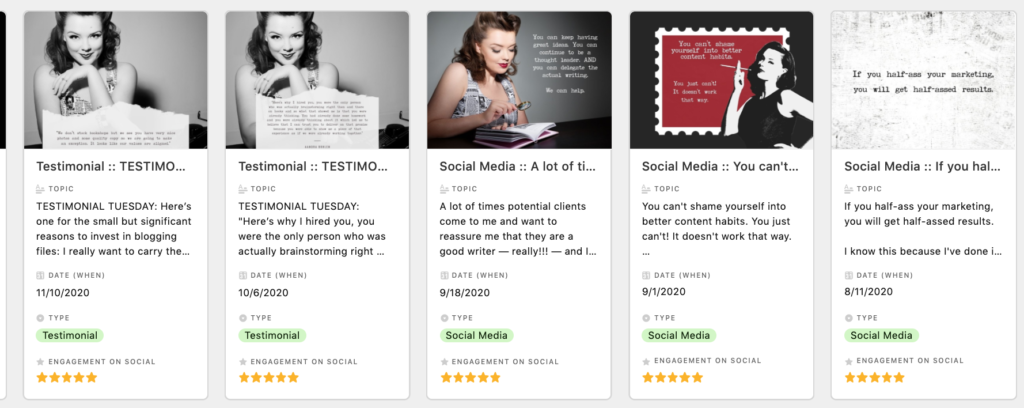My friend and colleague, Bushra Azhar, recently wrote a Facebook post that got my brain spinning.
In it she talks about her process of testing content — and then taking the content that works the best and spinning it out into many other things.
Now, this isn’t a new concept — I’ve talked ad nauseum about re-using, recycling, and repurposing content.
But what actually got me thinking is this: very few people actually do this with any sort of science or consistency behind it.
Bushra talks about making a mental note of things — which is awesome if your brain is not already full of spongey holes and Broadway musical song lyrics like mine is. 😉
But what about those sleeper posts? What about the content that takes off over time? What about the emails you don’t really notice doing well?
How do you take advantage of your best content when you’re not naturally inclined to notice or remember when a particular post does well?
Start with a content audit
A few years ago I wrote a really good instructional post on how to conduct a blog content audit. It goes into great detail about how to find your most popular content over the past year — and there’s even a checklist to go with it inside the Leadership Marketer’s Library.
If you haven’t particularly been paying attention to which content is performing the best over the past year, now is a great time to spend an hour or so doing a content audit.
There are lots of detailed questions to consider in that post, but the big ones for me are:
- Which were your top 5-10 most popular blog posts last year? And what were the top traffic sources to those posts?
- Which were your top 10 most popular social media posts last year?
- Which were your top 5-10 most well received emails last year?
If you’re not interested in auditing your past content, you can still set up a system by which you can make note of high-performing content going forward.
For example, in my Leadership Marketing Dashboard, I’ve added a column where I can rate posts with 1-5 stars by engagement. If I notice that a post gets over a certain number of engagements, it’s a 5-star post, and I mark it as such.

Once you have this basic information, you can start drawing some conclusions.
You might see patterns in which topics are really resonating with your audience. You might notice that a particular type of social media post (video, images, text, etc.) does better than others or that a particular style of email subject line gets the most opens.
With my 5-star system, I noticed that sharing testimonials about my work actually do really well on social media for me. That and stupid memes.
This is all valuable information.
But what do you… do with it?
Turn data into decisions — and dollars
In her post, Bushra gives this example:
2 years ago I recorded a video called, “How to Get People to Open Your Emails.” It was a smash hit, so what do you think I did? I seized the winner. If you go to my YouTube channel, you’ll see a webinar I did called, “How to Get People to Read Every Email You Send Them.” I then wrote a guest post on the topic, recorded a podcast episode, did half a dozen livestreams and still to this day, use this as one of the topics I blog about.
Once you’ve identified your content winners, you can spin them off into other formats.
You can republish and repost.
You can link to them and write follow up posts (kind of like I’m doing here, hint-hint).
But more than that, you can get some insight into what your audience is really interested in, what kind of content they want from you — and what they might be interested to buy.
One of the most valuable things you can do with this information is to refer to it when you’re writing sales and marketing copy, when you’re deciding what product to develop next, and so on. This is especially true when you’re getting comments that tell you exactly how people are feeling about your content.
Create a system for seizing your winners
The important take-away here is to create a system for making note of your winners.
This could be as simple as a literal document where you write down content you notice doing well.
It could be adding a field or column to your editorial calendar to note when posts do well.
It could be doing a content audit every year, or every few months.
It could even mean delegating a team member to take care of this for you.
Whatever you choose, the second half of the equation is to act on this information. Turn your data into decisions and dollar bills by using the information to make better content decisions in the future.
I promise it pays off.

![[A black and white photograph of a binder with an antique stamp collection inside. Laying on top of the stamps is a magnifying glass. The title of the blog post reads "Are you paying attention to what works in your content?" The Content Direction Agency logo is in the bottom right hand corner.]](https://lacyboggs.com/wp-content/uploads/2021/01/11_18-Blog-Post.jpg)
I do Income Taxes for locals. My focus on content is my relationship building with Facebook locals.
Chris
https://incometaxprepfillmore.com/income-tax-piru-ca
dadamsgjvjgqcuelndbibzureansjd
vgavcwnaeiahlnzkhmwkcytfgikpvt
rxbbotrntegqkoghedjhhqfqrrrxsf